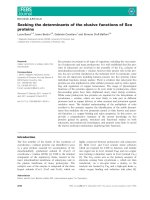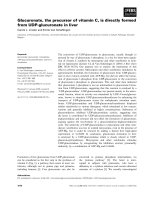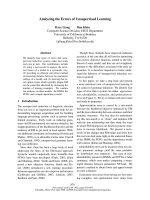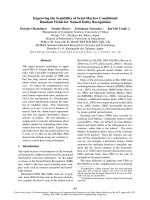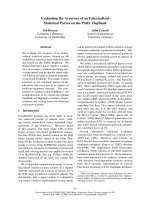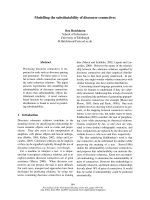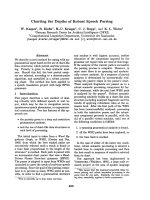Báo cáo khoa học: "Comparing the Accuracy of CCG and Penn Treebank Parsers" docx
Bạn đang xem bản rút gọn của tài liệu. Xem và tải ngay bản đầy đủ của tài liệu tại đây (109.96 KB, 4 trang )
Proceedings of the ACL-IJCNLP 2009 Conference Short Papers, pages 53–56,
Suntec, Singapore, 4 August 2009.
c
2009 ACL and AFNLP
Comparing the Accuracy of CCG and Penn Treebank Parsers
Stephen Clark
University of Cambridge
Computer Laboratory
15 JJ Thomson Avenue, Cambridge, UK
James R. Curran
School of Information Technologies
University of Sydney
NSW 2006, Australia
Abstract
We compare the CCG parser of Clark and
Curran (2007) with a state-of-the-art Penn
Treebank (PTB) parser. An accuracy com-
parison is performed by converting the
CCG derivations into PTB trees. We show
that the conversion is extremely difficult to
perform, but are able to fairly compare the
parsers on a representative subset of the
PTB test section, obtaining results for the
CCG parser that are statistically no differ-
ent to those for the Berkeley parser.
1 Introduction
There are a number of approaches emerging in sta-
tistical parsing. The first approach, which began in
the mid-90s and now has an extensive literature, is
based on the Penn Treebank (PTB) parsing task:
inferring skeletal phrase-structure trees for unseen
sentences of the WSJ, and evaluating accuracy ac-
cording to the Parseval metrics. Collins (1999) is a
seminal example. The second approach is to apply
statistical methods to parsers based on linguistic
formalisms, such as HPSG, LFG, TAG, and CCG,
with the grammar being defined manually or ex-
tracted from a formalism-specific treebank. Evalu-
ation is typically performed by comparing against
predicate-argument structures extracted from the
treebank, or against a test set of manually anno-
tated grammatical relations (GRs). Examples of
this approach include Riezler et al. (2002), Miyao
and Tsujii (2005), Briscoe and Carroll (2006), and
Clark and Curran (2007).
1
Despite the many examples from both ap-
proaches, there has been little comparison across
the two groups, which we refer to as PTB parsing
and formalism-based parsing, respectively. The
1
A third approach is dependency parsing, but we restrict
the comparison in this paper to phrase-structure parsers.
PTB parser we use for comparison is the pub-
licly available Berkeley parser (Petrov and Klein,
2007). The formalism-based parser we use is the
CCG parser of Clark and Curran (2007), which
is based on CCGbank (Hockenmaier and Steed-
man, 2007), a CCG version of the Penn Treebank.
We compare this parser with a PTB parser because
both are derived from the same original source,
and both produce phrase-structure in some form
or another; the interesting question is whether any-
thing is gained by converting the PTB into CCG.
2
The comparison focuses on accuracy and is per-
formed by converting CCG derivations into PTB
phrase-structure trees. A contribution of this paper
is to demonstrate the difficulty of mapping from a
grammatical resource based on the PTB back to the
PTB, and we also comment on the (non-)suitability
of the PTB as a general formalism-independent
evaluation resource. A second contribution is to
provide the first accuracy comparison of the CCG
parser with a PTB parser, obtaining competitive
scores for the CCG parser on a representative sub-
set of the PTB test sections. It is important to note
that the purpose of this evaluation is comparison
with a PTB parser, rather than evaluation of the
CCG parser per se. The CCG parser has been ex-
tensively evaluated elsewhere (Clark and Curran,
2007), and arguably GRs or predicate-argument
structures provide a more suitable test set for the
CCG parser than PTB phrase-structure trees.
2 The CCG to PTB Conversion
There has been much recent work in attempt-
ing to convert native parser output into alterna-
tive representations for evaluation purposes, e.g.
(Clark and Curran, 2007; Matsuzaki and Tsujii,
2008). The conclusion is that such conversions
are surprisingly difficult. Clark and Curran (2007)
2
Since this short paper reports a small, focused research
contribution, we refer readers to Clark and Curran (2007) and
Petrov and Klein (2007) for details of the two parsers.
53
shows that converting gold-standard CCG deriva-
tions into the GRs in DepBank resulted in an F-
score of only 85%; hence the upper bound on the
performance of the CCG parser, using this evalua-
tion scheme, was only 85%. Given that the current
best scores for the PTB parsing task are over 90%,
any loss from the conversion process needs to be
considered carefully if a fair comparison with PTB
parsers is to be achieved.
CCGbank was derived from the PTB, and so
it might be considered that converting back to
the PTB would be a relatively easy task, by es-
sentially reversing the mapping Hockenmaier and
Steedman (2007) used to create CCGbank. How-
ever, there are a number of differences between
the two treebanks which make the conversion back
far from trivial. First, the corresponding deriva-
tions in the treebanks are not isomorphic: a CCG
derivation is not simply a relabelling of the nodes
in the PTB tree; there are many constructions, such
as coordination and control structures, where the
trees are a different shape, as well as having differ-
ent labels. It is important to realise that Hocken-
maier and Steedman (2007) invested a significant
amount of time and effort in creating the mapping.
Second, some of the labels in the PTB do not ap-
pear in CCGbank, for example the QP label, and
these must be added back in; however, developing
rules to insert these labels in the right places is a
far from trivial task.
There were two approaches we considered for
the conversion. One possibility is to associate PTB
tree structures with CCG lexical categories, and
combine the trees together in step with the cate-
gory combinations in a CCG derivation — in much
the same way that an LTAG has elementary trees
in the lexicon which are combined using the sub-
stitution and adjunction rules of TAG. The second
approach is to associate conversion rules with each
local tree – i.e. a parent and one or two child nodes
– which appears in the CCGbank data.
3
In this pa-
per we took the second approach.
2.1 Conversion Schemas
There are three types of conversion schema:
schemas which introduce nodes for lexical items;
schemas which insert or elide PTB nodes for unary
3
Another possible approach has been taken by Matsuzaki
and Tsujii (2008), who convert HPSG analyses from a gram-
mar automatically extracted from the PTB back into the PTB.
They treat the problem as one of translation, learning a syn-
chronous grammar to perform the mapping.
TYPE RULE SCHEMA
lexical NP NP
lexical NP [nb]/N –
lexical (S [dcl ]\NP )/NP VP
unary S [dcl ] → NP\NP (SBAR l)
type- PP → l
raising (S \NP )\((S \NP )/PP )
binary NP [nb]/N N → NP[nb] >
binary NP S[dcl ]\NP → S [dcl ] (S l r)
binary NP /(S [dcl ]\NP ) (SBAR
S [dcl ]\NP → NP l (S r))
Table 1: Example conversion schemas
rules and type-raising; and schemas which can
perform arbitrary manipulation of generated PTB
subtrees for binary CCG rule instances. Examples
of these schemas are shown in Table 1. The pri-
mary operations in the binary schema are inserting
and attaching. Inserting a new node, for example
using the schema (S l r), creates a new S node
dominating both the left and right children of a bi-
nary rule. The attaching schema can attach the left
node under the right node (>); or the right node
under the left node (<).
The lexical categories NP and
(S [dcl ]\NP )/NP (shown in Table 1) intro-
duce the PTB nodes NP and VP, respectively,
while other lexical categories such as NP [nb]/N
introduce no extra nodes. Some unary rules
introduce nodes, such as SBAR for the reduced
relative case, whilst others, such as the type-raised
PP , do not. Finally, binary schemas may create
no new nodes (e.g. when a determiner is attached
to an existing NP), or one or more nodes (e.g. an
extra S node is created when a verb phrase finds
its subject).
A PTB tree is built from a CCG derivation by
running over the derivation in a bottom-up fashion
and applying these schemas to the local trees in
the derivation.
2.2 Schema development
The schemas were developed by manual inspec-
tion using section 00 of CCGbank and the PTB as
a development set, following the oracle method-
ology of Clark and Curran (2007), in which gold-
standard derivations from CCGbank are converted
to the new representation and compared with the
gold standard for that representation. As well as
giving an idea of the difficulty, and success, of the
conversion, the resulting numbers provide an up-
54
SECTION P R F COMP
00 (all) 93.37 95.15 94.25 39.68
00 (len ≤ 40) 94.11 95.65 94.88 42.11
23 (all) 93.68 95.13 94.40 39.93
23 (len ≤ 40) 93.75 95.23 94.48 42.15
Table 2: Oracle conversion evaluation
per bound on the performance of the CCG parser.
The test set, section 23, was not inspected at any
stage in the development of the schemas.
In total, we annotated 32 unary and 776 binary
rule instances (of the possible 2853 instances) with
conversion schemas, and 162 of the 425 lexical
categories. We also implemented a small num-
ber of default catch-all cases for the general CCG
combinatory rules and for the rules dealing with
punctuation, which allowed most of the 2853 rule
instances to be covered. Considerable time and ef-
fort was invested in the creation of these schemas.
The oracle conversion results from the gold
standard CCGbank to the PTB for section 00 and
23 are shown in Table 2. The numbers are brack-
eting precision, recall, F-score and complete sen-
tence matches, using the EVALB evaluation script.
Note that these figures provide an upper bound on
the performance of the CCG parser using EVALB,
given the current conversion process.
The importance of this upper bound should not
be underestimated, when the evaluation frame-
work is such that incremental improvements of a
few tenths of a percent are routinely presented as
improving the state-of-the-art, as is the case with
the Parseval metrics. The fact that the upper bound
here is less than 95% shows that it is not possi-
ble to fairly evaluate the CCG parser on the com-
plete test set. Even an upper bound of around 98%,
which is achieved by Matsuzaki and Tsujii (2008),
is not sufficient, since this guarantees a loss of at
least 2%.
4
3 Evaluation
The Berkeley parser (Petrov and Klein, 2007) pro-
vides performance close to the state-of-the-art for
the PTB parsing task, with reported F-scores of
around 90%. Since the oracle score for CCGbank
is less than 95%, it would not be a fair comparison
4
The higher upper bound achieved by Matsuzaki and Tsu-
jii (2008) could be due to the fact that their extracted HPSG
grammars are closer to the PTB than CCGbank, or due to their
conversion method. We leave the application of their method
to the CCG parser for future work.
to use the complete test set. However, there are a
number of sentences which are correct, or almost
correct, according to EVALB after the conversion,
and we are able to use those for a fair comparison.
Table 3 gives the EVALB results for the CCG
parser on various subsets of section 00 of the
PTB. The first row shows the results on only
those sentences which the conversion process can
convert sucessfully (as measured by converting
gold-standard CCGbank derivations and compar-
ing with PTB trees; although, to be clear, the scores
are for the CCG parser on those sentences). As can
be seen from the scores, these sentences form a
slightly easier subset than the full section 00, but
this is a subset which can be used for a fair com-
parison against the Berkeley parser, since the con-
version process is not lossy for this subset.
The second row shows the scores on those sen-
tences for which the conversion process was some-
what lossy, but when the gold-standard CCGbank
derivations are converted, the oracle F-measure is
greater than 95%. The third row is similar, but for
sentences for which the oracle F-score is geater
than 92%. The final row is for the whole of sec-
tion 00. The UB column gives the upper bound on
the accuracy of the CCG parser. Results are calcu-
lated using both gold standard and automatically
assigned POS tags; # is the number of sentences
in the sample, and the % column gives the sample
size as a percentage of the whole section.
We compare the CCG parser to the Berkeley
parser using the accurate mode of the Berke-
ley parser, together with the model supplied with
the publicly available version. Table 3 gives the
results for Section 23, comparing the CCG and
Berkeley parsers. The projected columns give
the projected scores for the CCG parser, if it per-
formed at the same accuracy level for those sen-
tences which could not be converted successfully.
The purpose of this column is to obtain an ap-
proximation of the CCG parser score for a perfect
conversion process.
5
The results in bold are those
which we consider to be a fair comparison against
the Berkeley parser. The difference in scores is
not statistically significant at p=0.05 (using Dan
Bikel’s stratified shuffling test).
One possible objection to this comparison is
that the subset for which we have a fair compar-
5
This is likely to be an upper bound on the performance
of the CCG parser, since the larger test sets contain sentences
which were harder to convert, and hence are likely to be more
difficult to parse.
55
SAMPLE # % UB actual F projected F
gold auto gold auto
00 (F=100) 759 39.7 100.00 94.19 93.41 – –
00 (F≥95) 1164 60.8 98.49 91.08 89.93 92.46 91.29
00 (F≥92) 1430 74.6 97.41 89.73 88.47 92.05 90.76
00 (all) 1913 100.0 94.25 87.00 85.60 92.00 90.52
Table 3: Results on the development set (CCG parser only)
SAMPLE # % UB Berkeley F actual F projected F
gold auto gold auto gold auto
23 (F=100) 961 39.9 100.0 93.38 93.37 93.83 92.86 – –
23 (F≥95) 1401 58.2 98.61 91.66 91.63 90.82 89.84 92.08 91.09
23 (F≥92) 1733 72.0 97.44 91.01 90.88 89.53 88.54 91.82 90.81
23 (all) 2407 100.0 94.40 89.67 89.47 86.36 85.50 91.20 90.29
Table 4: Results on the test set (CCG parser and Berkeley)
ison is likely to be an easy subset consisting of
shorter sentences, and so the most that can be
said is that the CCG parser performs as well as
the Berkeley parser on short sentences. In fact,
the subset for which we perform a perfect conver-
sion contains sentences with an average length of
18.1 words, compared to 21.4 for sentences with
40 words or less (a standard test set for reporting
Parseval figures). Hence we do consider the com-
parison to be highly informative.
4 Conclusion
One question that is often asked of the CCG
parsing work is “Why not convert back into the
PTB representation and perform a Parseval eval-
uation?” By showing how difficult the conver-
sion is, we believe that we have finally answered
this question, as well as demonstrating compara-
ble performance with the Berkeley parser. In addi-
tion, we have thrown further doubt on the possible
use of the PTB for cross-framework parser evalua-
tion, as recently suggested by Matsuzaki and Tsu-
jii (2008). Even the smallest loss due to mapping
across representations is significant when a few
tenths of a percentage point matter. Whether PTB
parsers could be competitive on alternative parser
evaluations, such as those using GR schemes, for
which the CCG parser performs very well, is an
open question.
Acknowledgements
James Curran was funded under Australian Re-
search Council Discovery grant DP0665973.
Stephen Clark was funded under EPSRC grant
EP/E035698/1.
References
Ted Briscoe and John Carroll. 2006. Evaluating the accu-
racy of an unlexicalized statistical parser on the PARC
DepBank. In Proceedings of the Poster Session of
COLING/ACL-06, Sydney, Austrailia.
Stephen Clark and James R. Curran. 2007. Wide-coverage
efficient statistical parsing with CCG and log-linear mod-
els. Computational Linguistics, 33(4):493–552.
Michael Collins. 1999. Head-Driven Statistical Models for
Natural Language Parsing. Ph.D. thesis, University of
Pennsylvania.
Julia Hockenmaier and Mark Steedman. 2007. CCGbank:
a corpus of CCG derivations and dependency structures
extracted from the Penn Treebank. Computational Lin-
guistics, 33(3):355–396.
Takuya Matsuzaki and Jun’ichi Tsujii. 2008. Comparative
parser performance analysis across grammar frameworks
through automatic tree conversion using synchronous
grammars. In Proceedings of COLING-08, pages 545–
552, Manchester, UK.
Yusuke Miyao and Jun’ichi Tsujii. 2005. Probabilistic dis-
ambiguation models for wide-coverage HPSG parsing. In
Proceedings of the 43rd meeting of the ACL, pages 83–90,
University of Michigan, Ann Arbor.
Slav Petrov and Dan Klein. 2007. Improved inference for
unlexicalized parsing. In Proceedings of the HLT/NAACL
conference, Rochester, NY.
Stefan Riezler, Tracy H. King, Ronald M. Kaplan, Richard
Crouch, John T. Maxwell III, and Mark Johnson. 2002.
Parsing the Wall Street Journal using a Lexical-Functional
Grammar and discriminative estimation techniques. In
Proceedings of the 40th Meeting of the ACL, pages 271–
278, Philadelphia, PA.
56
